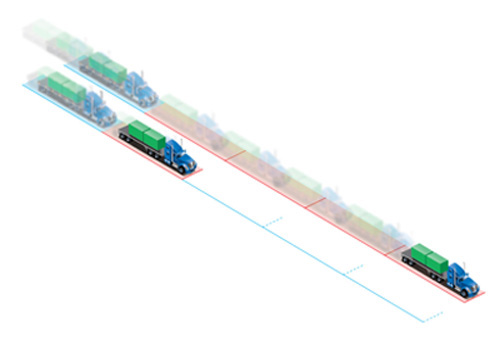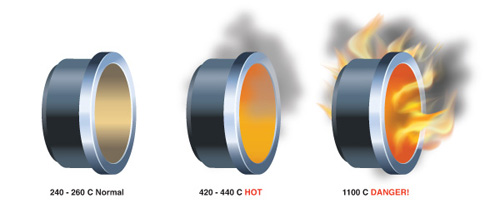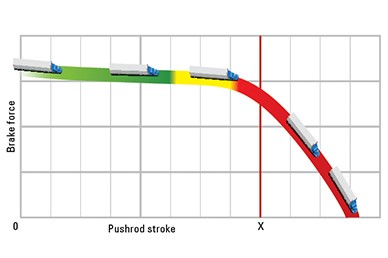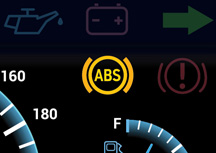Demands on Brakes While Driving
Several factors affect how your vehicle’s brakes work. These include the speed and weight of your vehicle, brake adjustment and anti-lock braking systems. This chapter explains the demand these factors place on the brake system while driving and what actions you should take to make sure your brakes work effectively.
Vehicle speed and weight
Increasing how much weight your vehicle carries or how fast you drive increases the demand on your brake system. As it increases, the brakes must do more work. In an air brake system, this means greater brake application pressure will be needed to meet the higher demand. To achieve this, you must press the brake pedal farther.

Diagram 7-1: Double vehicle weight – Double your stopping distance
Weight - Brake systems are designed for use on vehicles that are loaded within their rated capacity. Exceeding the weight capacity of a vehicle places abnormal demands on its brake system.
Vehicle weight affects the brake system in the following ways:
- The stopping distance will increase in proportion to any increase in vehicle weight (See Diagram 7-1).
- It is possible to exceed the capacity of a vehicle’s braking system by loading more weight than it is rated to carry.
- When a vehicle is overloaded, the brake system may not be able to safely stop it.
Speed - As vehicle speed increases, the stopping distance increases at a rate that is greater than the change in speed. For example, when speed is doubled, the stopping distance increases by four times (See Diagram 7-2).

Diagram 7-2: Double vehicle speed – Quadruple your stopping distance.
Note: If you double your vehicle weight and double your speed, your stopping distance increases by eight times.
When considering a vehicle’s stopping distance, many factors must be taken into account. Stopping distance can be calculated based on time and speed. A split-second delay in brake application and release ranging up to one-half second is present in all air brake systems. This delay must be taken into account when determining suitable following distances and appropriate action during vehicle stops.
Brakes create heat
Brakes convert the energy of a moving vehicle into heat. The frequency and type of brake use determines how much heat is created. When brakes are used repeatedly - such as when travelling down a long or steep hill or driving in stop-and-go traffic - or when severe braking takes place, the operating temperature of the brakes can become higher than normal. In some cases, brake temperatures can become so severe they cause damage to brake components (See Diagram 7-3).
Driving habits affect the amount of heat that develops in the brakes. Good driving habits include anticipating road conditions and leaving enough time to stop. In particular, keeping a safe distance behind other vehicles reduces the incidence of harsh brake use and excessive heat build-up in the brakes.
Some vehicles use engine brakes, retarders or auxiliary brakes - fitted onto drive lines that use engine compression, hydraulic or electric means - to slow it and assist in avoiding excessive brake temperature.

Diagram 7-3: Overheated brakes and components can be dangerous.
Brake fade
As brake components heat up, you may experience a reduction in their effectiveness and find that you need to press harder on the brake pedal to develop enough brake force. This is known as brake fade, and it is more noticeable on some vehicles than others.
In extreme cases, such as travelling down a long hill at excessive speed or with an overloaded vehicle, brake fade can become so severe and result in such a significant loss of brake force that you may be unable to slow or stop your vehicle.
Brakes must be adjusted correctly
Full brake capacity is not often needed during normal conditions. However, for safety, the full capacity of the brake system must always be available.
The brake force produced at a wheel drops significantly when the stroke of its brake chamber pushrod becomes excessive. When pushrod stroke becomes excessive, the vehicle loses some of its ability to stop (See Diagram 7-4). It is unlikely that you will notice a small loss of braking ability during normal driving. It may only become evident when higher demands are placed on the brakes such as heavier loads, higher speeds, long downhill grades or emergency stops.
When brake chamber pushrod stroke exceeds the adjustment limit, braking ability can be reduced so much that the brakes may not stop or hold the vehicle. Brakes must be kept properly adjusted to ensure each chamber pushrod stroke is within its adjustment limit.
Remember: Proper brake adjustment ensures that the brake chamber always produces the necessary force. When a brake is out of adjustment - when pushrod stroke exceeds the adjustment limit - braking ability is reduced.
The Ontario Highway Traffic Act and regulations require vehicles with air brakes to be checked at least once each day to ensure correct adjustment. Adjustment limits are prescribed for each style, size and type of air brake chamber (click here to see chart.) The pushrod stroke of each air brake chamber must not exceed its adjustment limit. Vehicles have full braking ability only when all brakes are properly adjusted.
Brakes that are out of adjustment cannot be detected except by a reliable inspection method.

Diagram 7-4: Brake force and pushrod stroke – after maximum adjustment limit is exceeded (at X), brake effectiveness declines rapidly and significantly down to zero.
Anti-lock braking systems
When a wheel locks and a tire skids, a vehicle loses steering control and directional stability. Under certain driving conditions, you may find it difficult to get the brake force you want without causing one or more of the wheels to lock. Anti-lock braking systems, which are also called ABS, are designed to sense the speed of the wheels on a vehicle. An abnormal drop in wheel speed, which indicates potential wheel lock, causes the brake force to be reduced to that wheel. This is how the anti-lock braking system prevents tire skid and the accompanying loss of steering control. This improves vehicle safety during heavy brake use or when braking with poor traction.
Although anti-lock braking systems help to prevent wheel lock, you should not expect the stopping distance for your vehicle to be shortened. Under normal driving conditions on clean dry roads, you will notice no difference between vehicles with anti-lock braking and those without it.
Vehicles with anti-lock braking systems use warning indicator lights or malfunction lamps to indicate the status of the system and warn of malfunctions. These indicator lights are mounted on the dashboard or driver console (See Diagram 7-5). On trailers, the indicators are usually mounted in locations that make them visible in your rear-view mirror. You should be familiar with the location of anti-lock braking system indicators on your vehicle and how they work.
Important: If an anti-lock braking system malfunction occurs, regular brake function is still available.

Diagram 7-5 ABS light illuminates to warn of brake malfunction
Key points to remember
- The demands on the brake system increase as vehicle speed or weight increases.
- Overloading a vehicle can cause it to lose its braking ability.
- Repeated or severe use of brakes causes higher brake temperatures.
- High brake temperatures can cause the vehicle’s braking ability to fade.
- When brakes are out of adjustment - when pushrod stroke exceeds the adjustment limit - braking ability is reduced.
- Anti-lock braking systems (ABS) help maintain steering control during emergency braking.
- Anti-lock braking systems help to prevent wheel lock but do not shorten vehicle stopping distance.
- Warning indicator lights are used with anti-lock braking systems to indicate system malfunctions.